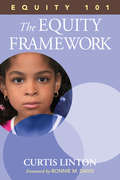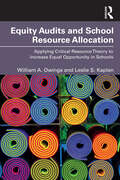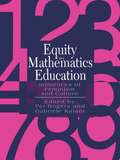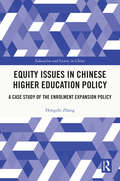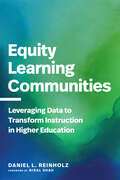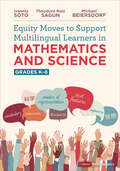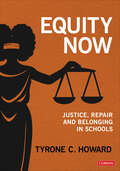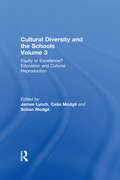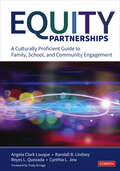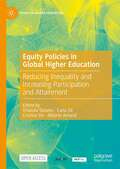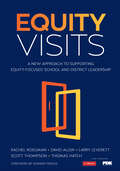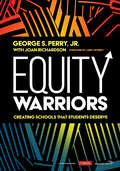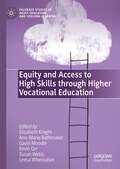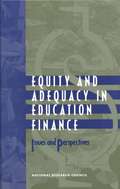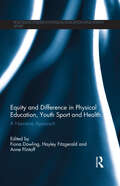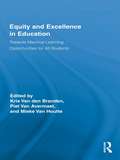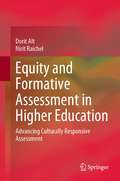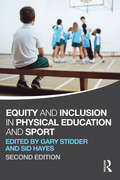- Table View
- List View
Equitable and Inclusive School Education: Ideation to Implementation
by Bharti KaushikThis book highlights the strategies and approaches to the practice of equitable and inclusive school education, elaborating the role of various stakeholders such as teachers, special educators, parents, peers, teacher educators, educational administrators and Ed-tech firms.The aim of this book is to create an understanding of equitable and inclusive school education which is not restricted to children with disabilities but also includes children with different learning needs as well as those from socially and economically disadvantaged sections of society. The focus is on presenting practical strategies that are grounded in theory and supported with research. The significance of screening at the classroom level, development of need-based accessible learning teaching materials, customizing the pedagogy practices for inclusive classrooms, need-based examination accommodations, leveraging the potential of Information and Communication Technology (ICT) to elicit the participation of all and collaborative efforts toward realizing the optimum potential of each learner are a few basic ideas illustrated in the book with examples. The volume also discusses recent national and international policies for equitable and inclusive education, recommending courses of action for effective implementation of the existing provisions by teachers and educators.The book will be useful to students, researchers, teacher-educators, special educators, special education teacher educators, pre-service teachers and parents. It will also be an invaluable companion to in-service teachers, policymakers and educational administrators, curriculum developers and NGOs working in the field of inclusive education.
Equity 101- The Equity Framework: Book 1
by Curtis W. LintonEquity is key to eliminating achievement gaps This first volume of a four-book series outlines a simple, yet powerful approach to creating the expectations, rigor, relevancy, and relationships necessary for any child to succeed. Equity 101 describes school systems that have changed their climate, culture, and practices to foster high levels of achievement. Best-selling author Curtis Linton introduces the three essential characteristics of equity: Clear expectations for closing the achievement gap Commitment to rigorous curriculum Relationships that promote learning Readers will have access to online videos that are keyed to central concepts of the series.
Equity 101: Book 2
by Curtis W. Linton Bonnie M. DavisHelp a culture of equity grow and thrive in your school! This second book in the groundbreaking Equity 101 series takes on the cultures we come from and the culture we foster in our schools. When diversity is the norm, how do we create an equitable culture where everyone succeeds? Your path starts with increasing educators’ cultural competency, overcoming institutionalized factors that limit achievement, and implementing equitable practices that ensure individualized support for all students. Resources include: Real-life success stories to use as models Chapter-specific implementation exercises that take you from ideas to action A dedicated online community for professional support
Equity Audits and School Resource Allocation: Applying Critical Resource Theory to Increase Equal Opportunity in Schools
by Leslie S. Kaplan William A. OwingsEquity Audits and School Resource Allocation explores how to apply Critical Resource Theory (CReT) to conduct school equity audits, ultimately preparing educational leaders to find equity disparities, engage in more equitable resource allocation in their schools, and improve equal educational opportunity for every student. With case study scenarios woven throughout the book, the authors explore key equity factors, including per-pupil expenditures, poverty, teacher and principal quality, program equity, and achievement equity. They also walk through the process of implementing the 5-step CReT equity audit within a school district or school at any level. Owings and Kaplan also describe the communication and interpersonal factors that equity advocates will need to leverage to gain community support for equity process, considering the data, and rethinking their policies and practices. In today’s education context, the problems of equitably funding public schools and allocating learning resources to generate more equal opportunities and higher outcomes for traditionally underserved children are particularly relevant. This important book is designed for course use in leadership preparation programs, for practicing principals and superintendents, and for educational leadership scholars.
Equity In Mathematics Education: Influences Of Feminism And Culture
by Gabriele KaiserThis text provides a critical overview of current thinking about equity issues in the teaching and learning of mathematics. Grounded in feminist theories of curriculum change and a broad range of cultural perspectives, the new approaches described here go beyond "special programmes" and "experimental treatments" designed to correct perceived problems and deficits. Instead they establish how improved instructional practices and a fuller understanding of the nature of the mathematical enterprise can overcome the systemic obstacles that have thwarted women's participation in this important field.; This book will appeal to all those who are interested in the mathematical education of women, including teachers, parents, administrators and researchers.
Equity Issues in Chinese Higher Education Policy: A Case Study of the Enrolment Expansion Policy (ISSN)
by Hongzhi ZhangInvestigating the highly influential enrolment expansion policy in Chinese higher education, this book outlines how educational equity issues were understood and addressed in the formulation and implementation of the policy, and its impacts on the socio-economic fabric of China in the past decades.Drawing on Chinese policy documents and interviews with government and university representatives, Zhang examines the education system under the Mao era and the post-Mao era and outlines the different approaches to equity that have characterized education in China in the 20th and 21st centuries. Stephen Ball’s "policy cycle" is used as a framework to analyse the various contexts (text, discourse, and social practice) in which policy is formed. Zhang argues that education policy was not simply driven by concerns of equity but also by economic interests and political discourse. Zhang further goes on to analyse how education policy was implemented by provincial governments and highlights the tension between central policy and on-the-ground implementation.Bringing analysis of Chinese policy and research to a wider audience, this text will interest education policymakers and academics in the field of educational equity and higher education research.
Equity Learning Communities: Leveraging Data to Transform Instruction in Higher Education
by Daniel L. ReinholzConcrete strategies for making higher education instruction more equitable via professional learning groups that use empirical classroom data to guide iterative, incremental changes
Equity Moves to Support Multilingual Learners in Mathematics and Science, Grades K-8 (Corwin Mathematics Series)
by Ivannia Soto Theodore Sagun Michael BeiersdorfA strengths and assets-based approach to multilingual learner success As the number of multilingual learners (MLLs) in US schools continues to grow, educators need to learn the moves necessary to support the success of these students in mathematics and science. Equity Moves to Support Multilingual Learners in Mathematics and Science, Grades K-8 focuses on the literacy opportunities that MLLs can achieve when language scaffolds are taught alongside rigorous math and science content. It provides a framework teachers can use to develop equity-centered, scaffolded math, science, or STEAM lessons. Readers will find Anchor phenomena that demonstrate issues with lesson design and delivery and highlight areas to include language and content scaffolds Examples for honoring the languages of students, families, and communities Culturally responsive techniques and easy-to-use tables featuring the equity moves Vignettes showcasing the equity move in the classroom setting A focus on four language demands: vocabulary, discourse, multiple modes of representation, and text features With an assets-based approach to what MLLs can do, this book helps teachers unpack the language demands of mathematics and science and encourages reflection of their own practices in scaffolding for language and culture.
Equity Moves to Support Multilingual Learners in Mathematics and Science, Grades K-8 (Corwin Mathematics Series)
by Ivannia Soto Theodore Sagun Michael BeiersdorfA strengths and assets-based approach to multilingual learner success As the number of multilingual learners (MLLs) in US schools continues to grow, educators need to learn the moves necessary to support the success of these students in mathematics and science. Equity Moves to Support Multilingual Learners in Mathematics and Science, Grades K-8 focuses on the literacy opportunities that MLLs can achieve when language scaffolds are taught alongside rigorous math and science content. It provides a framework teachers can use to develop equity-centered, scaffolded math, science, or STEAM lessons. Readers will find Anchor phenomena that demonstrate issues with lesson design and delivery and highlight areas to include language and content scaffolds Examples for honoring the languages of students, families, and communities Culturally responsive techniques and easy-to-use tables featuring the equity moves Vignettes showcasing the equity move in the classroom setting A focus on four language demands: vocabulary, discourse, multiple modes of representation, and text features With an assets-based approach to what MLLs can do, this book helps teachers unpack the language demands of mathematics and science and encourages reflection of their own practices in scaffolding for language and culture.
Equity Now: Justice, Repair, and Belonging in Schools
by Tyrone C. HowardIf not now, when? Anchored in the tenets of justice, repair, and belonging, Equity Now is a comprehensive guide for educators that emphasizes the urgent need for immediate action to dismantle systemic barriers in education. Aimed at K-12 professionals at all levels of the education system, the book urges us to move beyond individual efforts by applying an equity lens to our policies and practices. Through honest, sustained, and critical dialogues in "brave spaces," educators can address disparities and create equity-centered school communities. Equity Now proposes a solutions-oriented approach to fostering welcoming, affirming, responsive, and rigorous learning environments. Author Tyrone C. Howard, one of the leading authorities on issues related to racial inequality in our schools, provides An equity framework grounded in justice, repair, and belonging A clear vision of equity-focused leadership Essential practices, strategies, and resources for classroom teachers Suggestion for engaging parents, families and caregivers in schools Recommendations for engaging data in an equity based way Reflection questions and additional resources at the close of each chapter This book is a must-read for educators, administrators, and policymakers who are committed to creating conditions in which our children can reach their highest potential.
Equity Now: Justice, Repair, and Belonging in Schools
by Tyrone C. HowardIf not now, when? Anchored in the tenets of justice, repair, and belonging, Equity Now is a comprehensive guide for educators that emphasizes the urgent need for immediate action to dismantle systemic barriers in education. Aimed at K-12 professionals at all levels of the education system, the book urges us to move beyond individual efforts by applying an equity lens to our policies and practices. Through honest, sustained, and critical dialogues in "brave spaces," educators can address disparities and create equity-centered school communities. Equity Now proposes a solutions-oriented approach to fostering welcoming, affirming, responsive, and rigorous learning environments. Author Tyrone C. Howard, one of the leading authorities on issues related to racial inequality in our schools, provides An equity framework grounded in justice, repair, and belonging A clear vision of equity-focused leadership Essential practices, strategies, and resources for classroom teachers Suggestion for engaging parents, families and caregivers in schools Recommendations for engaging data in an equity based way Reflection questions and additional resources at the close of each chapter This book is a must-read for educators, administrators, and policymakers who are committed to creating conditions in which our children can reach their highest potential.
Equity Or Excellence? Educ & C
by James Lynch Sohan Modgil Celia ModgilFirst published in 1992. Routledge is an imprint of Taylor & Francis, an informa company.
Equity Partnerships: A Culturally Proficient Guide to Family, School, and Community Engagement
by Randall B. Lindsey Reyes L. Quezada Cynthia L. Jew Angela R. Clark-LouqueHow often do you hear, "The only parents who showed were the parents who didn’t need to be here." But how often do you consider time of day, lack of child care, cost of dinner, transportation, language of the presentation, even relevance of the topic—all real-world barriers for families of our historically underserved students. Here at last is a resource that will open up access and reveal all-new ways to forge more culturally inclusive partnerships with families and communities . . . partnerships that extend well beyond parent-teacher conferences, PTA meetings, and the occasional bake sale. The two big services Equity Partnerships provides? Using the Tools of Cultural Proficiency, you’ll Discover new concepts and strategies to engage families and communities—and reduce, if not eliminate, barriers--through four essential principles: communication, connection, collaboration, and community Engage in frequent opportunities to reflect on your own assumptions and values, then collaborate with colleagues to co-create systemic practices and policies for devising, implementing, and assessing family and community engagement actions in your schools and districts We know inherently that family and community engagement is critical to the success of our students. Let Equity Partnerships be your go-to tool for breaking down the walls that for too long have limited all of us. "Raising the next generation is a shared responsibility and privilege. These authors have been first responders for decades by promoting Cultural Proficiency as a means to ensure equity and access for all. In Equity Partnerships, they identify the powerful and critical link of family, school, and community engagement to strengthen families, build community support, and increase student success." --TRUDY ARRIAGA, Associate Dean for Equity and Outreach, California Lutheran University, and Coauthor of Opening Doors
Equity Partnerships: A Culturally Proficient Guide to Family, School, and Community Engagement
by Randall B. Lindsey Reyes L. Quezada Cynthia L. Jew Angela R. Clark-LouqueHow often do you hear, "The only parents who showed were the parents who didn’t need to be here." But how often do you consider time of day, lack of child care, cost of dinner, transportation, language of the presentation, even relevance of the topic—all real-world barriers for families of our historically underserved students. Here at last is a resource that will open up access and reveal all-new ways to forge more culturally inclusive partnerships with families and communities . . . partnerships that extend well beyond parent-teacher conferences, PTA meetings, and the occasional bake sale. The two big services Equity Partnerships provides? Using the Tools of Cultural Proficiency, you’ll Discover new concepts and strategies to engage families and communities—and reduce, if not eliminate, barriers--through four essential principles: communication, connection, collaboration, and community Engage in frequent opportunities to reflect on your own assumptions and values, then collaborate with colleagues to co-create systemic practices and policies for devising, implementing, and assessing family and community engagement actions in your schools and districts We know inherently that family and community engagement is critical to the success of our students. Let Equity Partnerships be your go-to tool for breaking down the walls that for too long have limited all of us. "Raising the next generation is a shared responsibility and privilege. These authors have been first responders for decades by promoting Cultural Proficiency as a means to ensure equity and access for all. In Equity Partnerships, they identify the powerful and critical link of family, school, and community engagement to strengthen families, build community support, and increase student success." --TRUDY ARRIAGA, Associate Dean for Equity and Outreach, California Lutheran University, and Coauthor of Opening Doors
Equity Policies in Global Higher Education: Reducing Inequality and Increasing Participation and Attainment (Issues in Higher Education)
by Alberto Amaral Orlanda Tavares Cristina Sin Carla SáThis book discusses and analyses global policies and practices aimed at promoting equity in higher education participation and attainment. Although the massification of higher education systems has facilitated the participation of students from deprived backgrounds, socioeconomic inequalities persist in access to the most prestigious institutions and programmes. Privileged students benefit from a number of advantages in the competition for selective and scarce places: access to information, lower aversion to debt, higher expectations, better previous schooling and higher academic achievement. The chapters present a critical analysis of equity policies in different countries – with or without affirmative action policies, within a context of neoliberal policies or within a social democratic model – and the reasons why they have failed to promote equity and fairness, preventing students from achieving their full educational potential.This is an open access book.
Equity Visits: A New Approach to Supporting Equity-Focused School and District Leadership
by David Allen Larry Leverett Scott T. Thompson Thomas C. Hatch Rachel D. RoegmanBecause equity and instruction are inextricably bound Why are equity visits such a critical first step to increasing opportunity and access for our under-served students? Because they take instructional rounds to a new level, providing a powerful lens for investigating the intersections of equity and instruction. After all, how can we possibly deliver equitable learning experiences, opportunities, and outcomes for our students, without first pinpointing problems of practice? That’s where Equity Visits will prove absolutely indispensable to district and school administrators. It details how to combine a strong focus on instruction with explicit, intentional efforts to address systemic inequities. Inside you’ll find A range of data collection activities and tools to target central issues of equity in your school Clear guidelines on how to investigate the ways instructional practices, structures, and beliefs lead to inequitable educational experiences—and how these are often masked in the day-to-day life of schools and districts A frank discussion of how to make race and racism an explicit part of investigating and addressing educational inequities Voices of school and district leaders who have taken crucial first steps to become "equity warriors" Recommendations on how to develop policies, initiatives, and practices to confront those inequities Few dispute that instructional improvement must be a central focus of educational leadership, but for too long achieving educational equity has been absent from the conversation. Here is your opportunity to ensure equity occupy a central spot in data collection and analysis, and be explicitly discussed at all levels of your school or district organization. In short, essential reading and doing for all administrators!
Equity Visits: A New Approach to Supporting Equity-Focused School and District Leadership
by David Allen Larry Leverett Scott T. Thompson Thomas C. Hatch Rachel D. RoegmanBecause equity and instruction are inextricably bound Why are equity visits such a critical first step to increasing opportunity and access for our under-served students? Because they take instructional rounds to a new level, providing a powerful lens for investigating the intersections of equity and instruction. After all, how can we possibly deliver equitable learning experiences, opportunities, and outcomes for our students, without first pinpointing problems of practice? That’s where Equity Visits will prove absolutely indispensable to district and school administrators. It details how to combine a strong focus on instruction with explicit, intentional efforts to address systemic inequities. Inside you’ll find A range of data collection activities and tools to target central issues of equity in your school Clear guidelines on how to investigate the ways instructional practices, structures, and beliefs lead to inequitable educational experiences—and how these are often masked in the day-to-day life of schools and districts A frank discussion of how to make race and racism an explicit part of investigating and addressing educational inequities Voices of school and district leaders who have taken crucial first steps to become "equity warriors" Recommendations on how to develop policies, initiatives, and practices to confront those inequities Few dispute that instructional improvement must be a central focus of educational leadership, but for too long achieving educational equity has been absent from the conversation. Here is your opportunity to ensure equity occupy a central spot in data collection and analysis, and be explicitly discussed at all levels of your school or district organization. In short, essential reading and doing for all administrators!
Equity Warriors: Creating Schools That Students Deserve
by Joan Richardson George S. PerryAdvance equity by learning to crack the system’s codes We must act now, using what we already know, to advance equity and raise the achievement of every student. With three decades of leading equity work across the country, George S. Perry Jr. issues a call to action for educational leaders who are willing to fight the fight for equity for all students. School and district leaders will encounter roadblocks as they enact systemic change, but Equity Warriors introduces practical, realistic, and strategic approaches for navigating those barriers. Equity Warriors equips education leaders with the moves they can make today to achieve the vision that every student becomes a high achiever by Providing real school and district examples of systemic equity efforts Demonstrating the parallel work that school and district teams must do to achieve and sustain systemic change Cracking the codes in the domains of politics, diplomacy, and warfare to achieve the equity agenda. Equity Warriors is a must read for leaders at all levels of the system who have chosen to be in this fight and are ready to do what it takes to make the system work for all students.
Equity Warriors: Creating Schools That Students Deserve
by Joan Richardson George S. PerryAdvance equity by learning to crack the system’s codes We must act now, using what we already know, to advance equity and raise the achievement of every student. With three decades of leading equity work across the country, George S. Perry Jr. issues a call to action for educational leaders who are willing to fight the fight for equity for all students. School and district leaders will encounter roadblocks as they enact systemic change, but Equity Warriors introduces practical, realistic, and strategic approaches for navigating those barriers. Equity Warriors equips education leaders with the moves they can make today to achieve the vision that every student becomes a high achiever by Providing real school and district examples of systemic equity efforts Demonstrating the parallel work that school and district teams must do to achieve and sustain systemic change Cracking the codes in the domains of politics, diplomacy, and warfare to achieve the equity agenda. Equity Warriors is a must read for leaders at all levels of the system who have chosen to be in this fight and are ready to do what it takes to make the system work for all students.
Equity and Access to High Skills through Higher Vocational Education (Palgrave Studies in Adult Education and Lifelong Learning)
by Ann-Marie Bathmaker Kevin Orr Gavin Moodie Leesa Wheelahan Elizabeth Knight Susan WebbThis book explores new and distinctive forms of higher vocational education across the globe, and asks how the sector is changing in response to the demands of the 21st century. These new forms of education respond to two key policy concerns: an emphasis on high skills as a means to achieve economic competitiveness, and the promise of open access for adults hitherto excluded from higher education. Examining a range of geographic contexts, the editors and contributors aim to address these contexts and highlight various similarities and differences in developments. They locate their analyses within the various political and socio-economic contexts, which can make particular reforms possible and achievable in one context and almost unthinkable in another. Ultimately, the book promotes a critical understanding of evolving provisions of higher vocational education, refusing assumptions that policy borrowing from apparently ‘successful’ countries offers a straightforward model for others to adopt.
Equity and Adequacy in Education Finance: Issues and Perspectives
by National Research CouncilSpending on K-12 education across the United States and across local school districts has long been characterized by great disparities--disparities that reflect differences in property wealth and tax rates. For more than a quarter-century, reformers have attempted to reduce these differences through court challenges and legislative action. As part of a broad study of education finance, the committee commissioned eight papers examining the history and consequences of school finance reform undertaken in the name of equity and adequacy. This thought-provoking, timely collection of papers explores such topics as: What do the terms "equity" and "adequacy" in school finance really mean?How are these terms relevant to the politics and litigation of school finance reform?What is the impact of court-ordered school finance reform on spending disparities?How do school districts use money from finance reform?What policy options are available to states facing new challenges from court decisions mandating adequacy in school finance?When measuring adequacy, how do you consider differences in student needs and regional costs?
Equity and Difference in Physical Education, Youth Sport and Health: A Narrative Approach (Routledge Studies in Physical Education and Youth Sport)
by Anne Flintoff Fiona Dowling Hayley FitzgeraldIssues of equity remain an essential theme throughout the study and practice of physical education (PE), youth sport and health. This important new book confronts and illuminates issues of equity and difference through the innovative use of narrative method, telling stories of difference that enable students, academics and professionals alike to engage both emotionally and cognitively with the subject. The book is arranged into three sections. The first provides an overview of current theory and research on difference and inequality in PE, youth sport and health, together with an introduction to narrative forms of knowing. The second section includes short narratives about difference that bring to life the key themes and issues in a range of physical activity contexts. The third section draws upon a selection of narratives to offer detailed, practical suggestions for how they might be used in, or inform, teaching sessions. This is the first book to explore issues of equity through narrative, and the first to examine the pedagogical value of a narrative approach within PE, youth sport and health. With contributions from many of the world’s leading equity specialists, it will be invaluable reading for all students, scholars and professionals working in PE, youth sport, health, sports development, gender studies and mainstream education programmes.
Equity and Excellence in Education: Towards Maximal Learning Opportunities for All Students (Routledge Research in Education)
by Piet Van Avermaet Mieke Van Houtte Kris Van den BrandenThroughout the world, equity and excellence in education is a major issue of concern. International comparative studies such as those carried out by OECD (PISA) have launched a worldwide debate on the effectiveness of educational systems (macro level), schools (meso level) and teachers (micro level) in terms of enhancing equity and excellence. Inspired by the OECD research and spurred by national policy-making, quantitative and qualitative research studies have recently been conducted in different parts of the globe aiming to provide deeper insight into the crucial variables that have an impact on equity, excellence or both. Among the variables that have been identified as crucial in this respect are the pupils' gender and their socio-economic and linguistic background, teachers' expectations, cognitions and pedagogical approach in the classroom, parental support, financial aspects, educational policies (e.g. priority policies, multilingual policies, early start policies), and variables related to the structure of the educational structure and system (e.g. compulsory school age, comprehensive systems, support structures, system variables enhancing spread of learners). This volume aims to compile a rich collection of research-based contributions, providing a state-of-the-art resource on what we know about this topic today.
Equity and Formative Assessment in Higher Education: Advancing Culturally Responsive Assessment
by Dorit Alt Nirit RaichelThis book discusses instruction, learning, and assessment in higher education with an emphasis on several effective formative assessment tools and methods such as digital badges, reflective journals, and peer assessment used in learning environments comprising students of diverse, multicultural backgrounds. Each chapter provides a rich theoretical review, followed by a case study detailing the challenges involved in using those assessment methods in a diverse classroom, as well as practical suggestions for removing potential barriers, especially for minority students. Most of the narrated case studies are accompanied by episodes, thoughts, and feelings expressed by both students and instructors throughout the assessment processes. This book provides a valuable updated reference source for pedagogical and research purposes for a wide audience. Students, teachers, policymakers, curriculum designers, and teacher educators interested in fostering initiatives in higher education can undoubtably benefit from this book's contents, which are aimed at adapting teaching–learning assessment processes to the unique learning needs of culturally diverse student populations.
Equity and Inclusion in Physical Education and Sport (2nd Edition)
by Gary Stidder Sid HayesAn essential component of good practice in physical education is ensuring inclusivity for all pupils, regardless of need, ability or background. Now in a fully revised and updated new edition, Equity and Inclusion in Physical Education fully explores the theoretical and practical issues faced by physical education teachers today. The book amalgamates areas of critical debate within the world of physical education and is structured around the key topics of ability, special educational needs, gender, sexuality, social class, race and ethnicity. These issues are discussed in relation to principles of equity, equality of opportunity, pedagogy, differentiation, curriculum planning and cultural awareness. Other chapters explore contemporary themes such as healthism and obesity and values in physical education and policy, whilst a chapter new to this edition demonstrates the importance of reflexivity and critical self-reflection in good inclusive practice. As well as being a perfect introductory text for any course on inclusion or inclusive practice in physical education, the book offers invaluable, practical advice for established professionals, newly qualified teachers and trainees about how to meet equity and inclusion requirements. Examples of good practice are included throughout, as well as guidance on how to implement an inclusive PE curriculum within the school.

